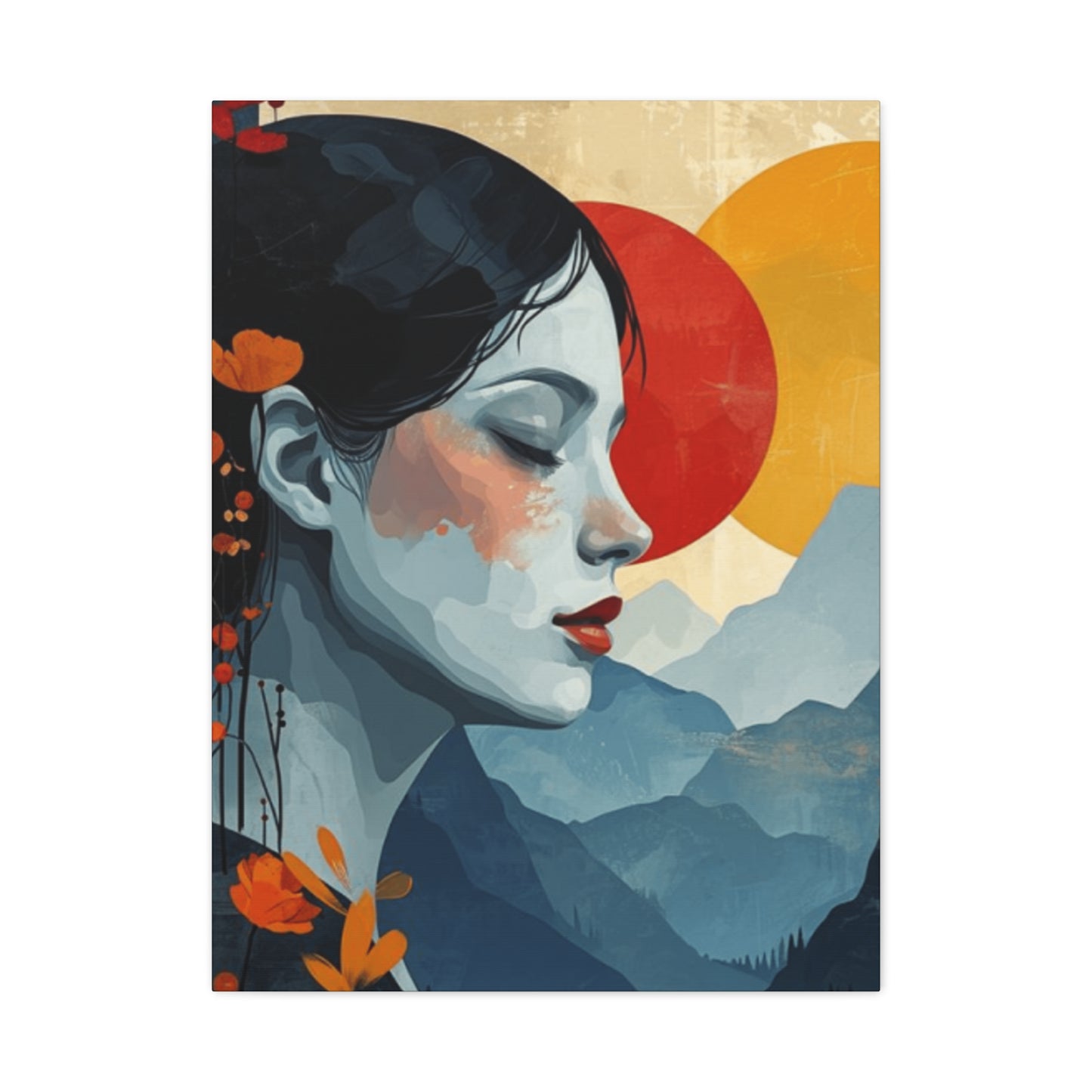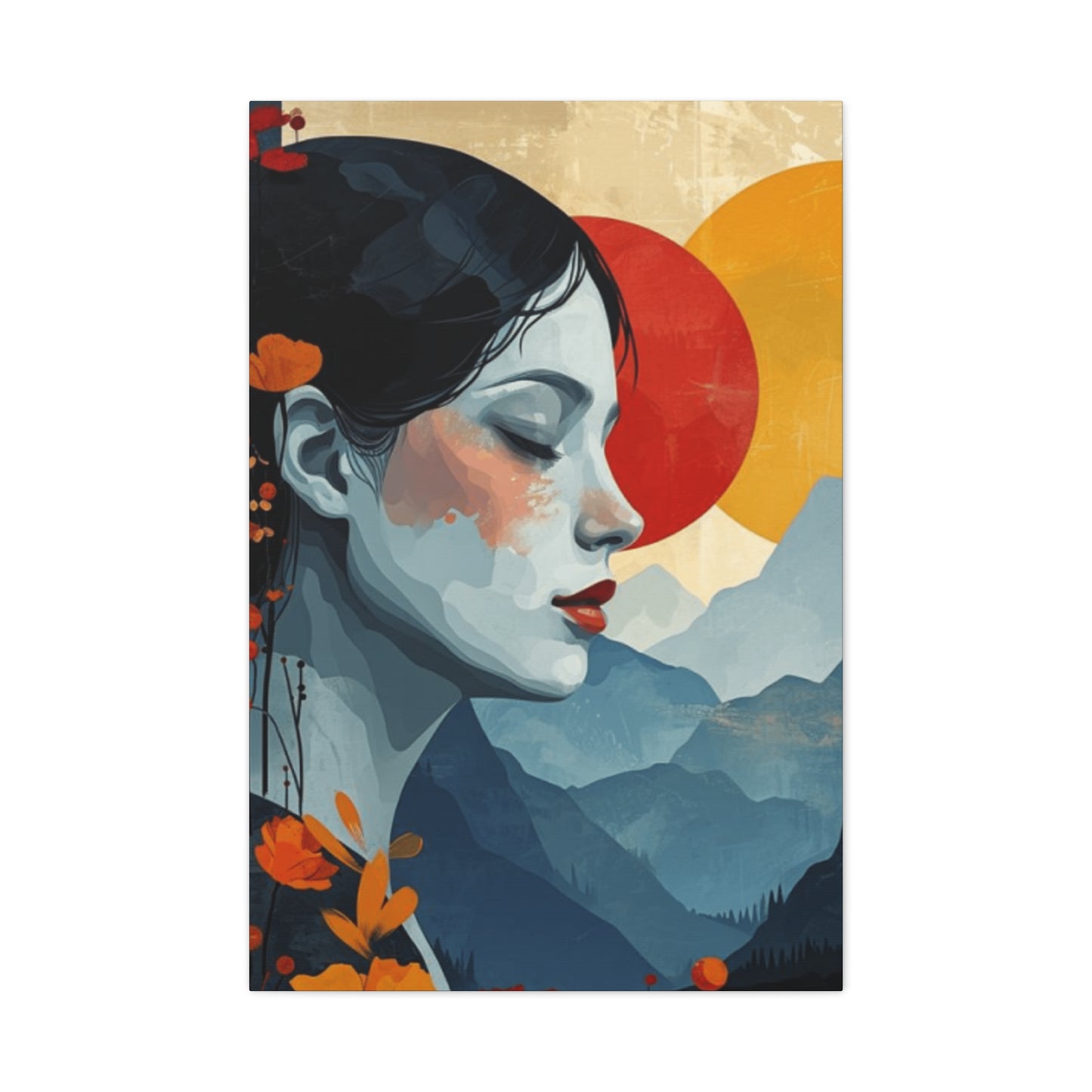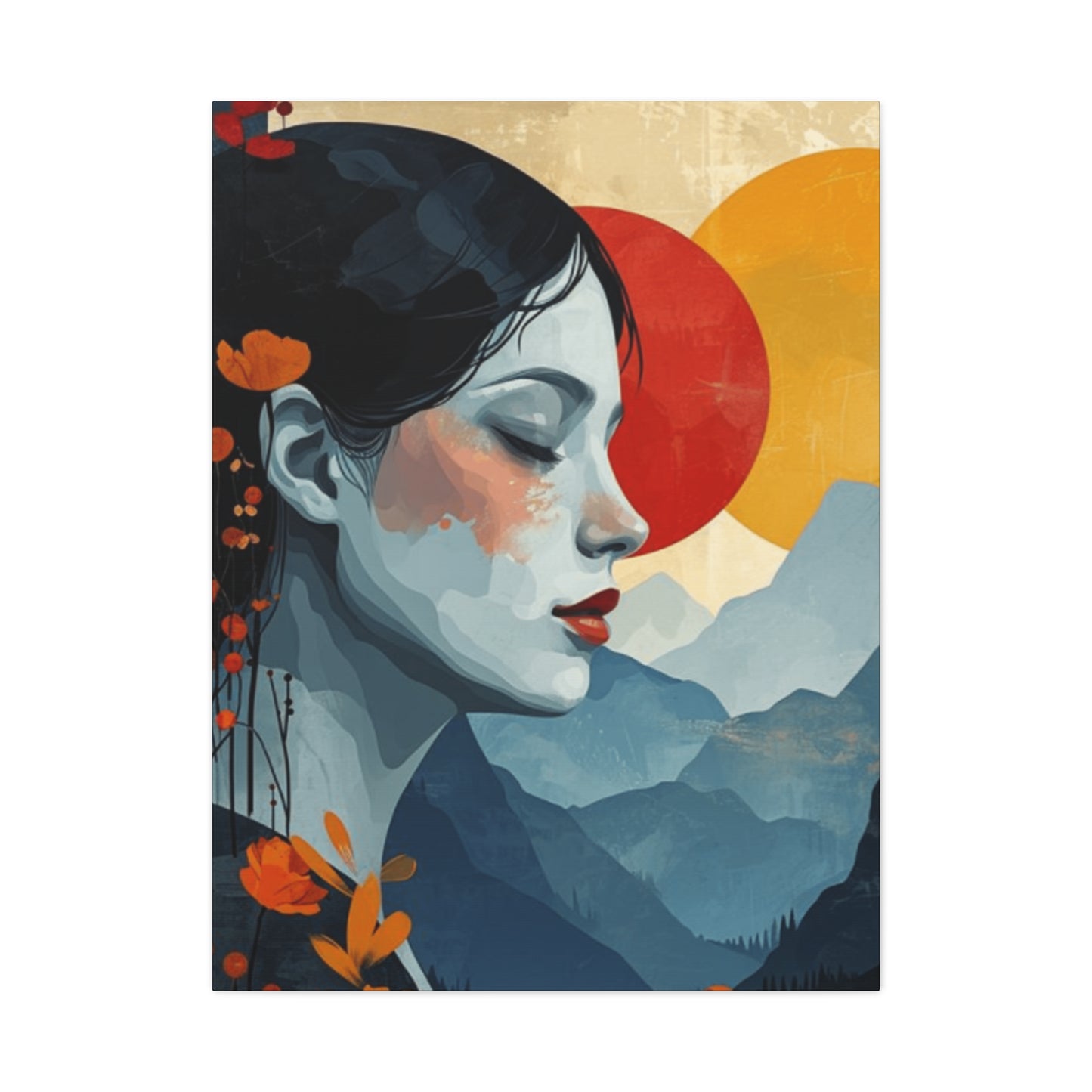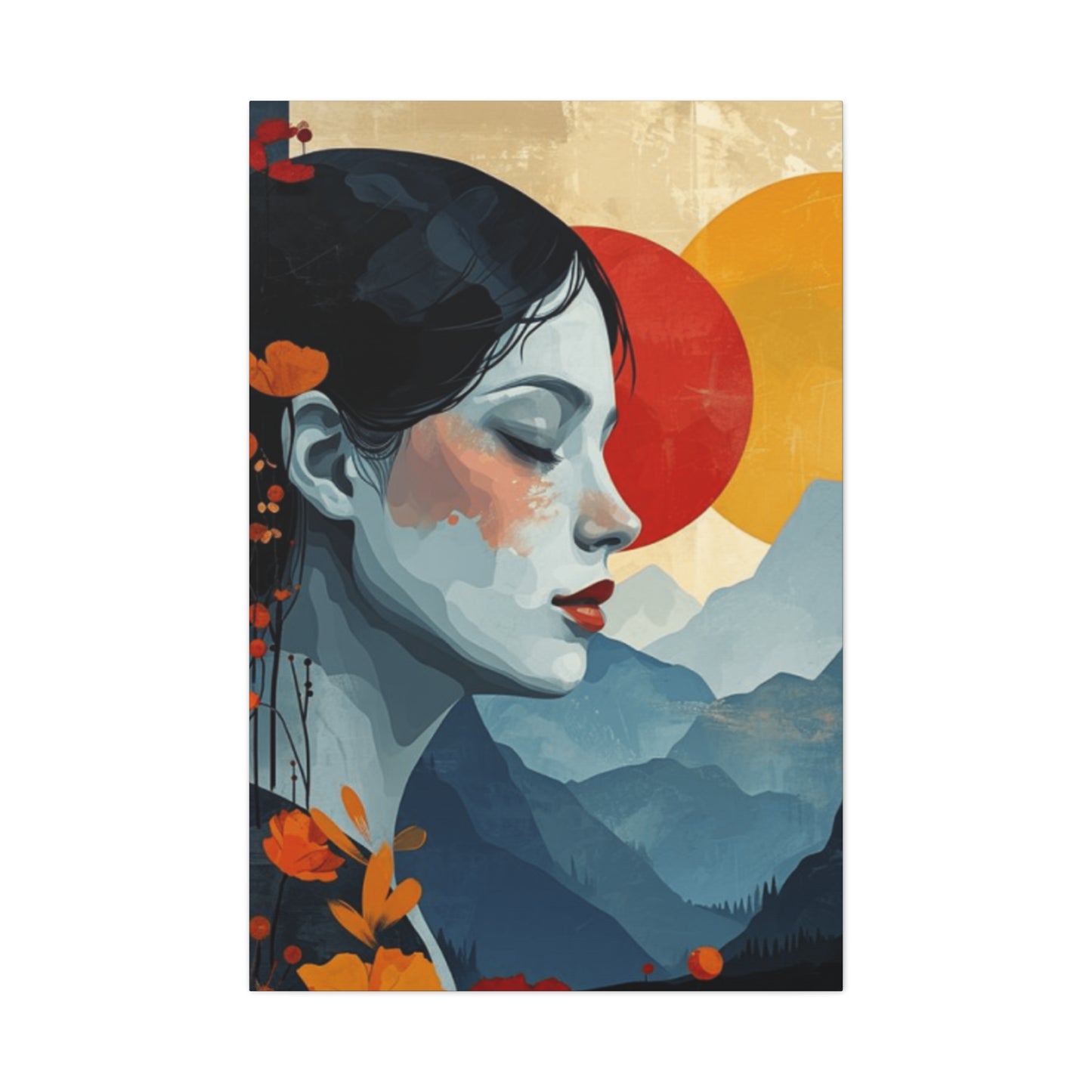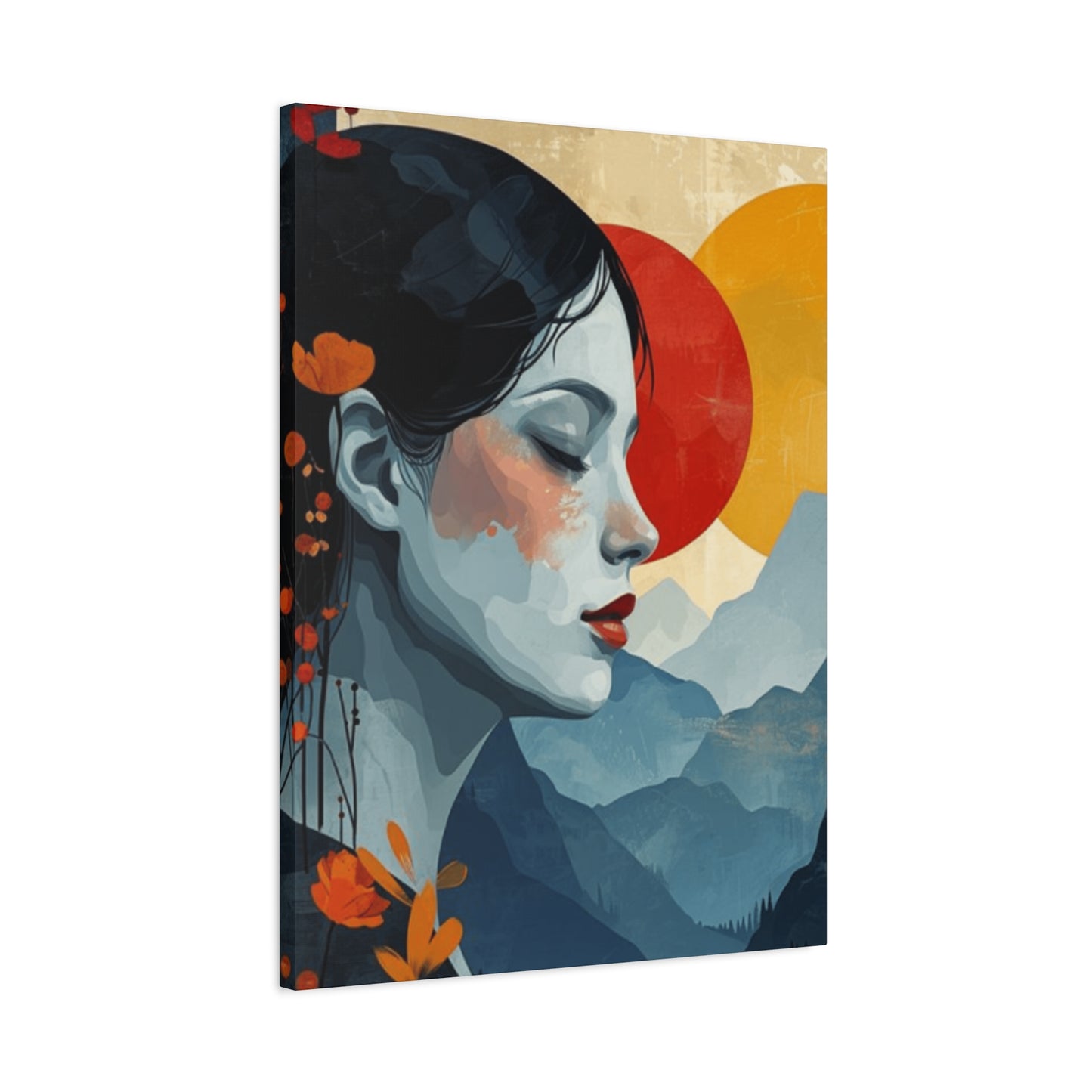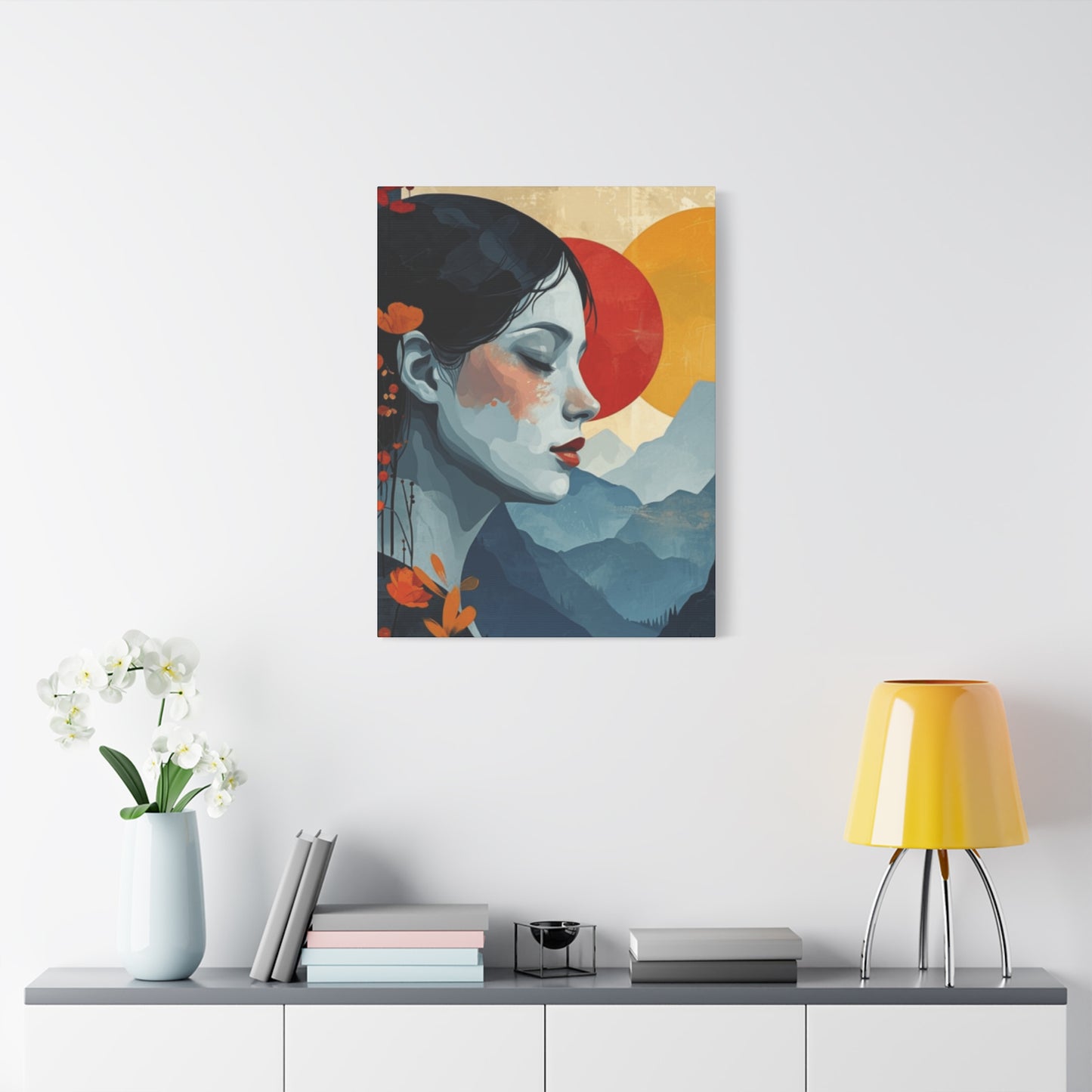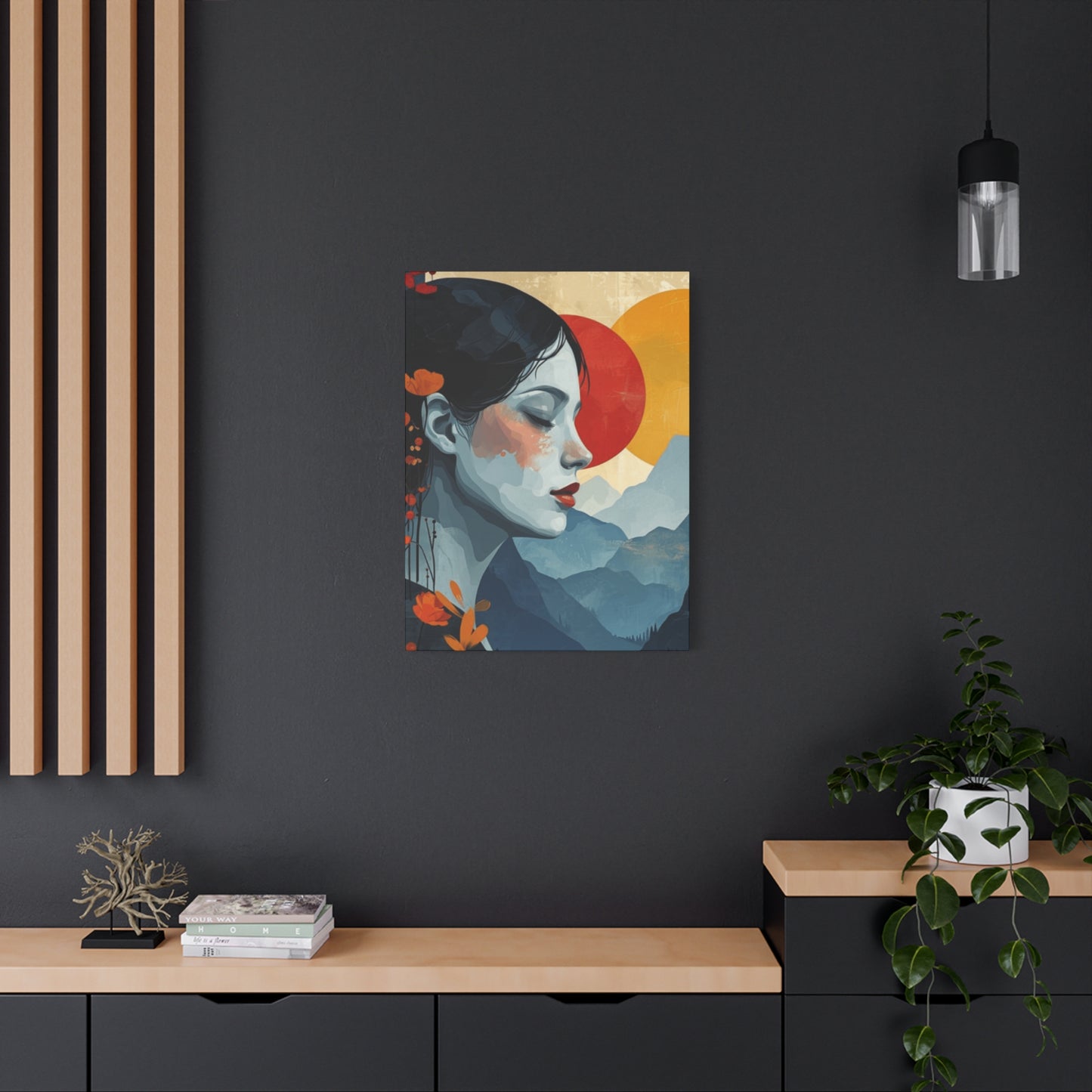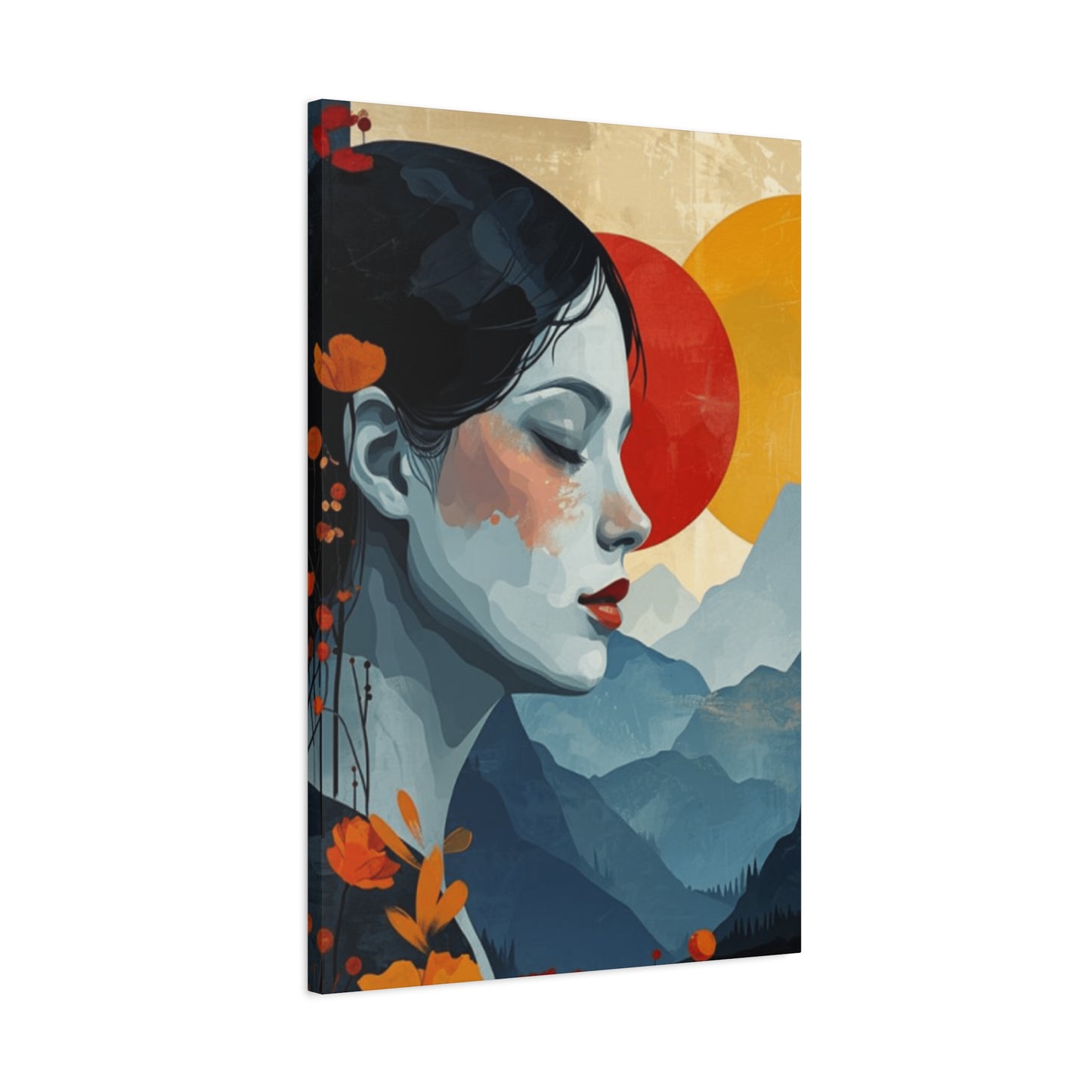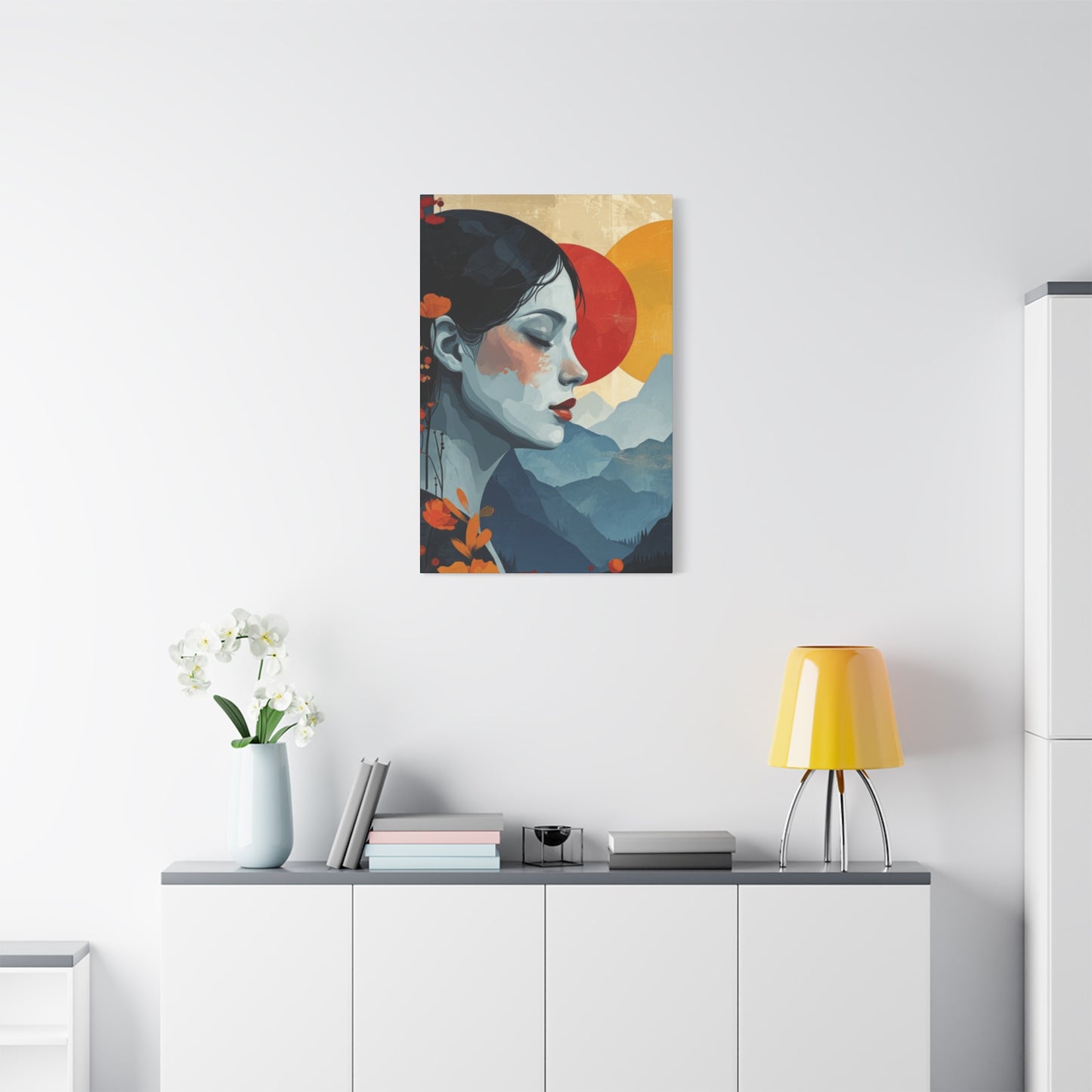Feminine Flower Wall Art: Honoring Women Through Nature’s Splendor
The captivating fusion of feminine portraits with botanical elements has emerged as one of the most sought-after trends in contemporary interior design. This artistic movement celebrates the natural connection between women and flowers, creating stunning visual narratives that speak to the soul while elevating any living space. The delicate interplay between human beauty and floral magnificence offers endless possibilities for artistic expression, making it a perfect choice for those seeking to infuse their homes with elegance, sophistication, and natural charm.
The growing popularity of feminine floral canvas art reflects our deep-seated appreciation for the timeless relationship between women and nature. These artistic creations transcend mere decoration, becoming powerful statements about beauty, grace, and the interconnectedness of human life with the natural world. Each piece tells a unique story, whether through subtle watercolor techniques, bold acrylic applications, or intricate mixed-media compositions that blend traditional portraiture with contemporary floral interpretations.
Graceful Botanical Expressions in Contemporary Wall Decor
The artistry of combining feminine portraits with floral elements creates a unique aesthetic language that speaks to viewers on multiple levels. These compositions draw inspiration from both classical artistic traditions and modern design sensibilities, resulting in pieces that feel simultaneously timeless and contemporary. The careful balance between human features and botanical details requires exceptional skill and artistic vision, as artists must seamlessly integrate natural elements without overwhelming the portrait's inherent beauty.
Contemporary artists working in this medium often employ various techniques to achieve stunning results. Some prefer realistic approaches that capture every petal and facial detail with precision, while others embrace abstract interpretations that suggest rather than define. The color palettes range from soft, muted tones that evoke tranquility and peace to vibrant, bold hues that command attention and create focal points within interior spaces. The versatility of this art form allows it to complement virtually any decorating style, from minimalist modern to ornate traditional settings.
The symbolic meaning embedded within these artistic works adds another layer of appreciation. Flowers have long been associated with various aspects of femininity, including beauty, growth, renewal, and the cycles of life. When combined with feminine portraits, these botanical elements create powerful metaphors for personal transformation, inner strength, and the natural evolution of the human spirit. The resulting artwork becomes more than decoration; it becomes a source of inspiration and contemplation for those who view it daily.
Professional interior designers increasingly recommend feminine floral canvas art for its ability to create emotional connections within living spaces. These pieces naturally draw the eye and invite closer examination, making them excellent conversation starters and focal points. The organic nature of floral elements softens harder architectural lines while adding warmth and personality to any room. Whether displayed as single statement pieces or arranged in carefully curated gallery walls, these artworks contribute to creating environments that feel welcoming, inspiring, and deeply personal.
Depicting Female Beauty Through Nature's Splendor
The artistic tradition of portraying women alongside flowers dates back centuries, but contemporary interpretations bring fresh perspectives to this classical theme. Modern artists explore new ways to integrate floral elements with feminine features, creating innovative compositions that challenge traditional boundaries while honoring historical influences. These contemporary works often feature women whose hair transforms into flowering vines, whose skin blooms with delicate petals, or whose entire being seems to emerge from or merge with garden landscapes.
The technical execution of these pieces requires mastery of multiple artistic disciplines. Artists must understand both human anatomy and botanical structure to create convincing integrations. The play of light and shadow across both skin and petals demands sophisticated color theory knowledge, while the composition must balance the organic flow of natural elements with the structured requirements of portraiture. Many artists spend years developing their unique approaches to this challenging artistic fusion.
Different cultural interpretations of feminine floral art offer diverse perspectives on the relationship between women and nature. Some traditions emphasize the nurturing aspects of this connection, depicting women as gardeners or earth goddesses surrounded by abundant blooms. Others focus on the decorative potential, showing women adorned with flower crowns or jewelry made from natural elements. Contemporary Western interpretations often emphasize empowerment and independence, presenting women who embody the strength and resilience found in nature.
The emotional impact of these artistic works cannot be understated. Viewers often report feeling uplifted, inspired, or peaceful when surrounded by feminine floral art. The combination of human beauty and natural elements triggers positive psychological responses, creating environments that promote wellbeing and creativity. This emotional resonance makes such artwork particularly valuable in spaces designed for relaxation, meditation, or creative pursuits.
Color psychology plays a crucial role in the effectiveness of feminine floral compositions. Warm floral tones like roses, pinks, and corals create feelings of comfort and nurturing, while cooler blues and purples evoke tranquility and spiritual connection. Green elements provide balance and harmony, while unexpected color combinations can create dynamic tension that energizes viewers. Skilled artists manipulate these color relationships to achieve specific emotional responses, making their work suitable for various interior design objectives.
Contemporary Canvas Collections Featuring Natural Beauty
The modern market for feminine floral canvas art reflects sophisticated consumer preferences for artwork that combines aesthetic appeal with emotional depth. Today's collectors seek pieces that not only enhance their living spaces but also reflect their personal values and aesthetic sensibilities. This demand has encouraged artists to push creative boundaries, experimenting with new techniques, materials, and interpretive approaches that keep this artistic category fresh and relevant.
High-quality canvas prints have made these artistic treasures accessible to broader audiences while maintaining the visual impact of original works. Advanced printing technologies now capture the subtle color gradations, texture variations, and fine details that make feminine floral art so compelling. Professional-grade canvases and archival inks ensure that these reproductions maintain their beauty for decades, making them worthwhile investments for home decorators and art enthusiasts alike.
The sizing options available for contemporary feminine floral canvas art accommodate virtually any space requirement. Large-scale pieces create dramatic focal points in spacious rooms, while smaller works provide intimate touches in personal spaces like bedrooms or reading nooks. Medium-sized options work well in dining areas, hallways, or home offices where they can provide visual interest without overwhelming the space. The availability of custom sizing options allows for perfect integration with existing decor schemes.
Framing choices significantly impact the final presentation of feminine floral canvas art. Traditional ornate frames complement classical interpretations, while sleek modern frames suit contemporary artistic approaches. Some pieces benefit from floating frames that create visual separation between the artwork and surrounding walls, while others look best with minimal or no framing to emphasize their organic nature. The frame selection process should consider both the artwork's style and the room's overall design aesthetic.
Gallery wall arrangements featuring multiple feminine floral pieces create stunning visual narratives that evolve as viewers move through the space. Successful groupings consider scale relationships, color harmonies, and thematic connections while maintaining visual balance. Professional curators recommend starting with a central anchor piece and building outward, maintaining consistent spacing and alignment for polished results. Mixed-scale arrangements often prove more visually interesting than uniform sizing, creating dynamic rhythms that hold viewer attention.
Romantic Design Elements in Feminine Wall Art
Romance in feminine floral art manifests through various visual elements that collectively create atmospheres of beauty, tenderness, and emotional warmth. Soft color palettes dominated by pastel hues evoke feelings of gentleness and affection, while flowing compositions suggest movement and dance-like grace. The interplay between light and shadow in these works often creates dreamy, almost ethereal qualities that transport viewers to idealized natural settings.
Artists working in the romantic tradition of feminine floral art often draw inspiration from historical periods known for their aesthetic refinement. Victorian-era sensibilities influence works featuring elaborate floral arrangements and formal portraiture styles, while Art Nouveau elements appear in pieces that emphasize organic flowing lines and stylized natural forms. These historical references create connections to artistic traditions while allowing for contemporary reinterpretations that speak to modern audiences.
The symbolic language of flowers adds layers of romantic meaning to these artistic works. Different blooms carry specific connotations that skilled artists incorporate into their compositions to enhance narrative depth. Roses traditionally symbolize love and passion, while lilies represent purity and renewal. Forget-me-nots suggest remembrance and true love, while peonies embody honor and wealth. Understanding these symbolic meanings allows viewers to appreciate additional layers of artistic intention.
Texture plays a crucial role in romantic feminine floral art, with artists often employing techniques that create tactile visual experiences. Soft brushwork might suggest the velvety quality of rose petals, while fine detail work captures the delicate structure of baby's breath or the intricate patterns found in iris blooms. Some artists incorporate mixed-media elements that add actual texture to their canvases, creating pieces that invite both visual and tactile engagement.
Lighting considerations become particularly important when displaying romantic feminine floral art. These pieces often benefit from soft, warm lighting that enhances their gentle color palettes and creates intimate viewing experiences. Natural light can beautifully illuminate these works during daytime hours, while carefully positioned accent lighting maintains their romantic appeal during evening hours. The interplay between artificial and natural lighting throughout the day can reveal different aspects of the same artwork, creating ever-changing visual experiences.
Modern Abstract Interpretations of Women and Flora
Abstract approaches to feminine floral art offer artists unprecedented freedom to explore emotional and symbolic connections between women and nature without the constraints of realistic representation. These interpretations often emphasize color relationships, gestural expressions, and compositional dynamics over literal depictions, creating artworks that communicate through pure visual language rather than recognizable imagery.
Contemporary abstract artists working in this medium often begin with realistic studies of both female subjects and floral elements before deconstructing these forms into essential emotional components. The resulting works might feature bold color fields that suggest blooming gardens, gestural marks that imply feminine movement, or abstract patterns that echo both human anatomical structures and botanical growth patterns. These pieces invite viewers to engage their imagination and personal interpretation rather than providing predetermined narratives.
Color field techniques prove particularly effective in abstract feminine floral compositions. Large areas of related hues can suggest vast flower meadows while simultaneously evoking emotional states associated with femininity. The gradual transitions between color zones create depth and movement that draw viewers into contemplative experiences. Some artists layer transparent glazes to build complex color relationships that shift and change depending on viewing angle and lighting conditions.
Gestural abstraction in feminine floral art captures the energy and movement inherent in both human expression and natural growth. Bold brushstrokes might suggest windblown hair that transforms into flowering branches, while delicate marks could represent both eyelashes and flower stamens. The scale of gestural elements within compositions affects their emotional impact, with larger marks creating more dramatic expressions and smaller marks building subtle atmospheric effects.
Mixed-media approaches expand the possibilities for abstract feminine floral art by incorporating materials and textures that traditional painting cannot achieve. Artists might embed dried flowers, fabric fragments, or metallic elements into their canvases to create pieces that bridge the gap between painting and sculpture. These textural additions add tactile dimensions that enhance the sensory experience of viewing the artwork.
The installation and display of abstract feminine floral art requires careful consideration of surrounding environments. These pieces often work best in spaces with clean lines and minimal distractions that allow their expressive qualities to dominate. However, they can also serve as dramatic counterpoints to more traditional decor when integrated thoughtfully. The abstract nature of these works makes them particularly suitable for contemporary residential and commercial spaces seeking sophisticated artistic statements.
Botanical Crown Designs in Decorative Art
The motif of women wearing floral crowns represents one of the most enduring and beloved themes in feminine botanical art. These compositions combine classical portraiture traditions with natural decorative elements to create works that celebrate both human beauty and nature's abundance. The crown motif itself carries rich symbolic meaning, suggesting celebration, achievement, natural royalty, and the harmonious relationship between humanity and the environment.
Historical precedents for floral crown imagery span numerous cultures and artistic traditions. Ancient Greek and Roman art frequently depicted goddesses and noble women adorned with laurel or flower wreaths, while medieval and Renaissance paintings often featured female saints with floral halos. These historical references provide contemporary artists with rich visual vocabularies to draw upon while creating modern interpretations that speak to current aesthetic sensibilities.
The technical challenges of depicting floral crowns require artists to master complex compositional relationships between human features and botanical elements. The crown must appear to naturally rest upon the subject's head while maintaining its own structural integrity as a floral arrangement. Different flower types require different approaches; delicate blossoms like baby's breath demand subtle techniques, while bold flowers like sunflowers or peonies need confident, decisive brushwork.
Color coordination between floral elements and skin tones requires sophisticated understanding of color theory and harmony. Warm-toned flowers complement warm skin undertones, while cool-toned blooms enhance cooler complexions. However, skilled artists often deliberately contrast these relationships to create dynamic visual tensions that energize their compositions. The interplay between complementary colors can make both the portrait subject and floral elements appear more vibrant and alive.
Different artistic styles bring unique interpretations to the floral crown motif. Realistic approaches emphasize botanical accuracy and precise portraiture, creating works that celebrate both natural beauty and human features with equal attention to detail. Impressionistic treatments focus on capturing the overall effect and emotional atmosphere rather than precise details, often resulting in more expressive and emotionally evocative works. Contemporary stylized approaches might simplify forms while emphasizing bold colors or graphic qualities.
The seasonal implications of different floral crown compositions allow artists to create series that celebrate the changing cycles of nature. Spring crowns might feature delicate blossoms like cherry flowers, apple blooms, or tulips, while summer compositions could showcase roses, peonies, or wildflower meadow varieties. Autumn crowns might incorporate late-blooming flowers alongside colorful foliage, while winter interpretations could feature evergreen elements, berries, or dried botanical materials.
Honoring Womanhood Through Botanical Imagery
The artistic celebration of femininity through botanical imagery creates powerful statements about the essential connections between women and the natural world. These artistic works acknowledge and honor the traditional associations between women and nature while also exploring contemporary interpretations that reflect modern understanding of gender, identity, and environmental consciousness. The resulting artworks serve as both aesthetic objects and cultural commentary on the evolving relationship between humanity and nature.
Cultural variations in the representation of women through botanical imagery reveal diverse perspectives on femininity, nature, and their interconnections. Western artistic traditions often emphasize individual beauty and personal expression, while Eastern approaches might focus more on harmony, balance, and spiritual connections. Indigenous artistic traditions frequently present women as earth mothers or plant spirits, emphasizing their roles as nurturers and guardians of natural resources.
The empowerment aspects of contemporary feminine botanical art challenge traditional passive representations of women in nature. Modern interpretations often depict strong, confident women who embody natural forces rather than simply being decorated by them. These subjects might appear as forest goddesses emerging from tree bark, ocean spirits composed of wave patterns and sea foam, or earth mothers whose bodies become fertile landscapes supporting abundant plant life.
Symbolic plant choices in feminine botanical art carry specific meanings that enhance the overall message of each piece. Flowers traditionally associated with femininity include roses for love and beauty, lilies for purity and rebirth, and lotus blossoms for spiritual awakening and resilience. However, contemporary artists often expand beyond traditional flower symbolism to include plants representing strength, independence, and growth, such as sunflowers, oak leaves, or climbing vines.
The therapeutic and inspirational qualities of feminine botanical art make these pieces particularly valuable in environments dedicated to healing, creativity, and personal growth. Healthcare facilities, wellness centers, creative studios, and meditation spaces benefit from the calming and uplifting effects these artworks provide. The combination of human beauty and natural elements creates psychological associations with growth, renewal, and positive transformation.
Environmental consciousness in contemporary feminine botanical art reflects growing awareness of ecological issues and the need for sustainable living practices. Many artists now incorporate messages about conservation, biodiversity, and environmental protection into their work, using the beauty of feminine botanical imagery to draw attention to important environmental causes. These pieces serve as both aesthetic objects and educational tools that promote greater environmental awareness.
Free-Spirited Floral Portrait Collections
The bohemian aesthetic in feminine floral art embraces freedom of expression, cultural diversity, and unconventional beauty standards while maintaining the essential connection between women and botanical elements. These artistic works often feature eclectic combinations of cultural influences, mixed-media techniques, and non-traditional composition approaches that reflect the free-spirited nature of bohemian lifestyle philosophies.
Color palettes in bohemian feminine floral art tend toward rich, saturated hues inspired by global textile traditions, natural dye techniques, and exotic flora. Deep purples, vibrant oranges, earthy browns, and golden yellows create warm, inviting compositions that feel both grounded and adventurous. These bold color choices reflect the bohemian appreciation for cultural diversity and artistic expression without restraint.
Mixed cultural elements frequently appear in bohemian feminine floral compositions, combining Western portraiture techniques with decorative patterns from various world traditions. Mandala-inspired backgrounds might frame portraits adorned with Native American-style flower crowns, while African textile patterns could provide context for subjects surrounded by tropical blooms. These cultural fusions celebrate global artistic heritage while creating unique contemporary expressions.
Texture and layering techniques in bohemian feminine floral art often incorporate actual materials alongside painted elements. Artists might embed fabric fragments, dried flowers, beads, or metallic threads into their canvases to create rich, tactile surfaces that invite closer examination. These mixed-media approaches reflect the bohemian appreciation for handcrafted objects and natural materials.
The lifestyle associations of bohemian feminine floral art make these pieces particularly appealing to individuals who value creativity, freedom, and connection to nature. These artworks work especially well in spaces decorated with natural materials, vintage textiles, and collected objects from various cultures. The eclectic nature of bohemian style allows these artistic pieces to coexist harmoniously with diverse decorative elements.
Spiritual and mystical themes often appear in bohemian feminine floral art, reflecting the lifestyle's openness to alternative belief systems and practices. Subjects might be depicted with third eyes surrounded by lotus blossoms, chakra symbols integrated into floral patterns, or crystal elements alongside botanical crowns. These spiritual references add deeper meaning layers that resonate with viewers seeking artwork that reflects their personal beliefs and practices.
Refined Floral Canvas Portraiture
The pursuit of refinement in feminine floral canvas portraiture represents the highest levels of artistic skill and aesthetic sophistication. These works demonstrate masterful technique in both portraiture and botanical illustration while maintaining perfect compositional balance between human and natural elements. The resulting pieces embody elegance and grace that elevate any interior space while providing lasting aesthetic satisfaction.
Technical excellence in refined floral portraiture requires years of study and practice to achieve the precise control necessary for success. Artists must master color mixing to achieve subtle skin tone variations, understand the complex structure of different flower types, and possess the drawing skills necessary to integrate these elements convincingly. The brushwork must be confident yet sensitive, capturing both the softness of petals and the firmness of human features.
Composition principles in refined feminine floral portraiture follow classical guidelines while allowing for creative interpretation and personal expression. The rule of thirds often governs the placement of key elements, while careful attention to positive and negative space ensures visual balance. Leading lines might be created through the arrangement of stems and leaves, drawing the viewer's eye through the composition in a predetermined pattern that enhances the overall viewing experience.
The selection of floral elements in refined portraiture reflects both artistic vision and botanical knowledge. Artists must understand how different flowers behave in various lighting conditions, how their colors interact with skin tones, and how their forms contribute to the overall composition. Some flowers provide delicate details that add subtle interest, while others offer bold shapes that create dramatic focal points.
Quality materials and techniques ensure that refined feminine floral portraiture maintains its beauty over time. Professional-grade canvases, high-quality paints, and proper varnishing techniques protect these investments while preserving their aesthetic impact. The archival quality of materials becomes particularly important for pieces intended as family heirlooms or gallery collections.
The market value of refined feminine floral portraiture reflects both the skill required to create these works and their enduring aesthetic appeal. Original pieces by established artists command significant prices, while high-quality reproductions make this art form accessible to broader audiences. The investment potential of quality pieces makes them attractive to both art collectors and home decorators seeking lasting value.
Simplistic Feminine Botanical Expression
Minimalist approaches to feminine floral art demonstrate that powerful artistic statements can emerge from simplified forms and restrained color palettes. These works rely on essential elements rather than complex details, creating compositions that feel peaceful, balanced, and effortlessly elegant. The minimalist aesthetic particularly suits contemporary interiors where clean lines and uncluttered spaces are valued.
The philosophy behind minimalist feminine floral art emphasizes the importance of negative space, subtle color relationships, and carefully chosen focal points. Each element within the composition must justify its presence by contributing meaningfully to the overall effect. This selective approach requires artists to possess deep understanding of their subject matter so they can identify and emphasize only the most essential characteristics.
Line quality becomes critically important in minimalist feminine floral works since fewer elements must carry greater expressive weight. A single contour line might define both a facial profile and the edge of a leaf, creating elegant economy of means. The pressure, speed, and confidence with which these lines are drawn directly affects the emotional impact of the finished piece.
Color relationships in minimalist feminine floral art often rely on monochromatic or analogous schemes that create subtle harmonies rather than dramatic contrasts. These restrained palettes encourage viewers to focus on form, composition, and emotional content rather than being distracted by bold color interactions. The limited color range also makes these pieces easier to integrate into existing interior design schemes.
The meditative qualities of minimalist feminine floral art make these pieces particularly suitable for spaces dedicated to relaxation and contemplation. Bedrooms, meditation rooms, spa facilities, and quiet reading areas benefit from the calming influence these simplified compositions provide. The absence of visual clutter allows viewers to appreciate subtle beauties that might be overlooked in more complex artworks.
Contemporary interior design trends increasingly favor minimalist approaches that emphasize quality over quantity, making feminine floral art in this style particularly relevant. These pieces can serve as focal points in otherwise simple rooms without overwhelming the space or competing with architectural features. Their understated elegance appeals to sophisticated consumers seeking refined artistic statements.
Timeless Elegance in Floral Female Art
Classical beauty standards and timeless aesthetic principles find perfect expression in feminine floral art that emphasizes elegance, grace, and enduring appeal. These works draw inspiration from historical artistic traditions while incorporating contemporary techniques and perspectives, creating pieces that feel both familiar and fresh. The emphasis on timeless qualities ensures these artworks remain relevant and beautiful regardless of changing fashion trends.
Historical influences in timeless feminine floral art include elements from Renaissance portraiture, Romantic period landscape painting, and Victorian decorative arts. These classical references provide established vocabularies of beauty that artists can reinterpret for contemporary audiences. The challenge lies in incorporating these traditional elements without creating works that feel dated or derivative.
Proportion and scale relationships in timeless feminine floral compositions follow classical guidelines that have proven their effectiveness over centuries of artistic practice. The golden ratio often governs the placement of key elements, while careful attention to scale ensures that human and botanical elements feel naturally integrated. These mathematical relationships create visual harmonies that feel intuitively pleasing to viewers.
The craftsmanship evident in timeless feminine floral art reflects dedication to traditional artistic skills and techniques. Careful drawing, sophisticated color mixing, and precise brushwork demonstrate respect for the craft traditions that have produced the world's greatest artworks. This commitment to quality ensures that these pieces will be appreciated by future generations as well as contemporary viewers.
Investment quality becomes an important consideration for timeless feminine floral art since these pieces are often purchased with the intention of long-term enjoyment and potential value appreciation. Works that demonstrate exceptional skill, use quality materials, and embody enduring aesthetic principles tend to maintain their appeal and value over time. The reputation of the artist and the rarity of the piece also influence long-term value potential.
The versatility of timeless feminine floral art allows these pieces to complement various decorating styles and adapt to changing interior design trends. Their classical foundations provide stability while their artistic quality ensures continued appreciation. This adaptability makes them excellent choices for individuals who prefer to invest in fewer, higher-quality pieces rather than frequently updating their art collections.
Contemporary Expressions of Women and Wildflowers
The combination of feminine subjects with wildflower elements creates artistic works that celebrate natural beauty in its most unrestrained and spontaneous forms. These compositions often emphasize the freedom, resilience, and diverse beauty found in both wild botanical environments and independent feminine spirits. The resulting artworks feel fresh, energetic, and connected to the natural world in immediate, visceral ways.
Wildflower varieties offer artists rich palettes of colors, forms, and textures that cultivate more structured garden flowers cannot provide. Field poppies provide brilliant reds and delicate tissue-paper textures, while Queen Anne's lace offers intricate white lacework patterns. Black-eyed Susans contribute bold yellow focal points, and purple lupines add vertical structural elements. The diversity of wildflower types allows for complex, varied compositions that feel naturally abundant.
The seasonal aspects of wildflower art enable artists to capture specific moments in natural cycles, from early spring wildflower carpets to late summer meadow abundance. Each season offers different color palettes and growth patterns that can enhance the emotional content of feminine subjects. Spring wildflowers suggest renewal and hope, while late summer varieties might convey maturity and fulfillment.
Environmental themes often appear in contemporary feminine wildflower art as artists use these works to raise awareness about habitat preservation and biodiversity conservation. The beauty of wildflower meadows serves as a powerful argument for protecting natural spaces, while the integration of feminine subjects suggests human responsibility for environmental stewardship. These pieces can serve educational purposes while providing aesthetic pleasure.
The spontaneous quality of wildflower growth patterns influences the compositional approaches artists use when incorporating these elements into feminine portraiture. Unlike formal garden flowers, wildflowers appear in irregular clusters, varying heights, and unexpected combinations. Artists must capture this natural randomness while maintaining overall compositional balance and visual coherence.
Location-specific wildflower art allows artists to celebrate regional botanical heritage while creating works that resonate with local audiences. Prairie wildflowers tell different stories than alpine meadow varieties or desert blooms. This regional specificity can make wildflower art particularly meaningful to viewers who recognize and connect with familiar local flora.
Dynamic Floral Elements in Modern Portraiture
Contemporary portrait artists increasingly incorporate bold floral elements that create dramatic visual impact while maintaining sophisticated artistic standards. These works often feature larger-scale compositions, saturated colors, and dynamic arrangements that command attention and create powerful focal points within interior spaces. The boldness of these approaches reflects contemporary confidence and willingness to make strong aesthetic statements.
Scale relationships in bold floral portraiture often deliberately violate traditional proportional rules to create more dramatic effects. Oversized flowers might dominate compositions, dwarfing human subjects to create surreal environments, or multiple small portraits might be surrounded by massive botanical forms. These scale manipulations create visual tension that keeps viewers engaged and interested.
Color saturation in bold feminine floral art often pushes beyond natural limitations to achieve more intense emotional impact. Artists might amplify the natural colors of both skin tones and floral elements, or introduce completely artificial color schemes that create fantastic, otherworldly effects. These enhanced color palettes can create moods and atmospheres that realistic representations cannot achieve.
Contemporary printing technologies enable the reproduction of bold feminine floral art at scales and qualities that maintain the impact of original works. Large-format digital printing can produce gallery-quality pieces that work effectively in commercial and residential spaces requiring substantial artistic presence. The availability of custom sizing options allows these bold works to be tailored to specific architectural requirements.
The psychological impact of bold feminine floral art can energize spaces and influence mood in positive ways. The combination of vibrant colors, dynamic compositions, and positive subject matter creates uplifting environments that promote creativity and well-being. These pieces work particularly well in creative studios, wellness centers, and social spaces where their energizing qualities can benefit multiple users.
Market demand for bold feminine floral art reflects contemporary preferences for distinctive, personality-driven interior design. Consumers increasingly seek art that makes personal statements rather than simply coordinating with existing decor. This trend toward bolder artistic choices has created opportunities for artists to explore more experimental approaches while finding appreciative audiences.
Enchanting Blossom-Surrounded Feminine Subjects
The artistic device of surrounding feminine subjects with abundant blossoms creates enchanted, fairy-tale-like atmospheres that appeal to viewers seeking escape from mundane realities. These compositions often feature subjects who appear to be emerging from or merging with flowering environments, creating magical narratives that celebrate the mystical connections between women and nature.
Environmental integration techniques in blossom-surrounded compositions require careful attention to lighting, color temperature, and spatial relationships. The transition between human subjects and their floral surroundings must feel natural rather than artificially imposed. This integration might be achieved through careful color coordination, similar lighting effects, or gradual transitions that blend human and botanical elements.
The storytelling potential of blossom-surrounded feminine art allows artists to create narrative works that suggest fairy tales, myths, or personal transformation stories. A subject emerging from rose bushes might represent awakening love, while someone surrounded by wildflowers could symbolize freedom and natural connection. These narrative elements add depth and meaning that enhance the purely aesthetic aspects of the work.
Different blossom types create different atmospheric effects in these enchanting compositions. Rose gardens suggest romance and luxury, while wildflower meadows evoke freedom and natural beauty. Cherry blossoms might add delicate, ephemeral qualities, while tropical blooms could create exotic, mysterious atmospheres. The choice of floral environment directly influences the emotional impact of the finished piece.
The fantasy elements common in blossom-surrounded feminine art allow artists to explore imaginative possibilities that realistic portraiture cannot accommodate. Subjects might have flower petals for hair, wings made of leaves, or skin that transitions into bark or flower stems. These fantastical elements create works that appeal to viewers seeking art that transports them beyond everyday reality.
Seasonal interpretations of blossom-surrounded compositions enable artists to create series that celebrate the changing cycles of nature throughout the year. Spring works might feature subjects emerging from fresh green growth and early blossoms, while autumn pieces could show figures surrounded by late-blooming flowers and colorful foliage. These seasonal variations provide opportunities for ongoing artistic exploration within consistent thematic frameworks.
Ethereal Botanical Feminine Artworks
The creation of ethereal qualities in botanical feminine art requires sophisticated understanding of light, atmosphere, and visual perception to achieve effects that seem to transcend physical reality. These works often feature soft, glowing lighting effects, translucent colors, and compositional elements that appear to float or dissolve into their surroundings. The resulting pieces create dreamlike experiences that transport viewers into imaginary realms.
Lighting techniques in ethereal botanical feminine art often employ backlighting, rim lighting, and atmospheric perspective to create luminous, otherworldly effects. Subjects might appear to glow from within, surrounded by halos of soft light that blur the boundaries between figure and background. These lighting effects can be achieved through various artistic techniques, from traditional glazing methods to contemporary digital manipulation.
Color transparency and layering techniques contribute significantly to the ethereal quality of these artistic works. Multiple transparent layers of paint or digital effects can create depth and luminosity that solid, opaque colors cannot achieve. The interaction between layers creates complex color relationships that seem to shift and change as viewers observe the work from different angles or under varying lighting conditions.
Compositional softness in ethereal botanical feminine art often eliminates hard edges and sharp transitions in favor of gradual blending and flowing forms. Subjects might appear to be dissolving into their floral surroundings, with hair becoming flower petals or skin transforming into leaf surfaces. These soft transitions create unity between human and botanical elements that enhances the overall ethereal effect.
The meditative and spiritual qualities associated with ethereal art make these pieces particularly suitable for spaces dedicated to relaxation, contemplation, and spiritual practices. Meditation rooms, healing spaces, and private retreats benefit from the calming, transcendent qualities these artworks provide. The otherworldly atmosphere can help viewers disconnect from daily stresses and connect with deeper emotional and spiritual states.
Contemporary digital art techniques have expanded the possibilities for creating ethereal effects in botanical feminine art. Digital layering, transparency effects, and particle systems can create atmospheric qualities that would be difficult or impossible to achieve through traditional painting techniques. However, successful digital ethereal art still requires strong foundational skills in composition, color theory, and artistic vision.
Rose-Adorned Female Canvas Creations
The rose stands as perhaps the most iconic flower in feminine art, carrying centuries of symbolic meaning related to love, beauty, passion, and feminine grace. Contemporary artists working with rose motifs in feminine portraiture must navigate these rich historical associations while finding fresh approaches that speak to modern audiences. The challenge lies in avoiding cliché while honoring the profound symbolic power that roses have accumulated through artistic tradition.
Color variations in roses provide artists with extensive palettes for creating different moods and symbolic meanings within their feminine portraits. Red roses traditionally symbolize passionate love and desire, making them suitable for dramatic, romantic compositions. Pink roses suggest gentler emotions like appreciation and grace, while white roses represent purity and new beginnings. Yellow roses convey friendship and joy, and purple roses add elements of mystery and enchantment.
The structural complexity of roses offers multiple opportunities for artistic exploration within feminine portraiture. The layered petal structure creates intricate patterns of light and shadow that can echo the subtle modeling of human features. The contrast between the delicate petals and sturdy thorns provides metaphorical material for exploring the complexity of feminine strength and vulnerability.
Historical rose symbolism in art provides contemporary artists with rich vocabulary for creating meaningful works. The Virgin Mary was often depicted with white roses, associating them with purity and divine grace. Medieval courtly love traditions connected red roses with passion and devotion, while Victorian flower language assigned specific meanings to different rose varieties and colors. Understanding these historical associations allows contemporary artists to layer meaning into their works.
Seasonal considerations affect both the availability of rose reference material and the emotional associations viewers bring to rose-themed art. Spring and summer roses suggest abundance and vitality, while roses depicted in autumn or winter settings might convey themes of endurance, memory, or the passage of time. The seasonal context can significantly influence the interpretation and emotional impact of feminine rose portraits.
The cultivation and care associated with roses can provide additional metaphorical content for feminine portraits featuring these flowers. The patience required to grow beautiful roses parallels the development of inner beauty and character, while the careful tending roses require suggests themes of nurturing and dedication. These agricultural associations can add depth to portraits that celebrate feminine strength and perseverance.
Gentle Pastel Botanical Portraits
The use of soft pastel colors in feminine botanical portraits creates works that emphasize tenderness, peace, and gentle beauty rather than dramatic impact or bold statements. These subtle color palettes often feature muted pinks, lavenders, soft yellows, and pale greens that create harmonious, soothing compositions. The restraint required to work successfully within these limited color ranges demands sophisticated understanding of color relationships and artistic sensitivity.
Color temperature considerations become particularly important when working with pastel palettes, as the subtle differences between warm and cool variations can significantly affect the emotional impact of the work. Warm pastels suggest comfort and nurturing, while cool pastels evoke tranquility and spiritual peace. The skilled manipulation of these temperature relationships allows artists to guide viewer emotions without relying on bold color contrasts.
The psychological effects of pastel colors make these botanical portraits particularly suitable for environments where calm, peaceful atmospheres are desired. Bedrooms, nurseries, meditation spaces, and healthcare facilities benefit from the soothing qualities that pastel botanical art provides. The gentle nature of these works makes them non-demanding yet emotionally nourishing additions to personal spaces.
Lighting considerations for pastel botanical portraits require careful attention to maintain the subtle color relationships that give these works their special character. Harsh lighting can wash out delicate color variations, while overly dim lighting might make the subtle details invisible. Soft, diffused lighting that mimics natural daylight often proves most effective for displaying pastel botanical works.
Seasonal associations with pastel colors create opportunities for themed collections that celebrate different times of year. Spring pastels might feature cherry blossoms, tulips, and fresh green growth, while summer works could showcase pale roses, lavender, and other garden flowers. Autumn pastels might emphasize the softer tones found in late-season blooms and changing foliage.
Conclusion
Feminine Flower Wall Art beautifully celebrates the elegance, strength, and grace of women through the timeless beauty of nature. By combining floral imagery with artistic expression, these artworks evoke a sense of serenity, empowerment, and inspiration, making them perfect additions to any living space. Each piece transforms walls into canvases that honor femininity, symbolizing growth, resilience, and the delicate yet powerful essence of womanhood. This type of wall art appeals to art lovers, nature enthusiasts, and anyone seeking to bring warmth, beauty, and meaningful symbolism into their interiors.
Incorporating feminine flower wall art into homes or offices allows for the creation of spaces that are both aesthetically pleasing and emotionally uplifting. In bedrooms, living rooms, or creative areas, these pieces serve as focal points that inspire reflection, calm, and connection to nature. In professional or wellness spaces, they convey messages of empowerment and nurturing energy, enriching the environment with elegance and positivity. The versatility of floral-themed art ensures it complements diverse décor styles, from modern minimalism and contemporary chic to bohemian or traditional interiors, adding softness, color, and visual harmony.
The artistic craftsmanship behind feminine flower wall art emphasizes detail, texture, and emotional resonance. Artists skillfully render petals, stems, and blooms using vibrant or subtle color palettes, delicate brushwork, and layered composition to convey depth and movement. Each artwork captures the natural beauty of flowers while infusing symbolic meaning, transforming the visual experience into a celebration of feminine strength, grace, and individuality. The resulting pieces are more than decoration—they are expressions of art that communicate both aesthetic pleasure and meaningful storytelling.
Ultimately, Feminine Flower Wall Art elevates interiors by merging nature’s splendor with the celebration of womanhood. It transforms walls into spaces of inspiration, reflection, and beauty, offering both emotional and visual enrichment. By incorporating these artworks, individuals can honor femininity, enhance their décor with elegance, and create environments that are inviting, vibrant, and emotionally resonant—making it a timeless and empowering addition to any living space.










